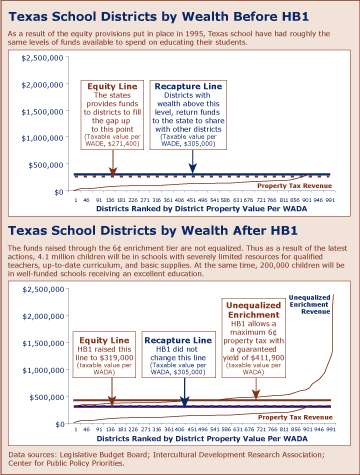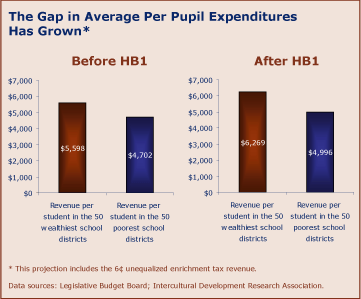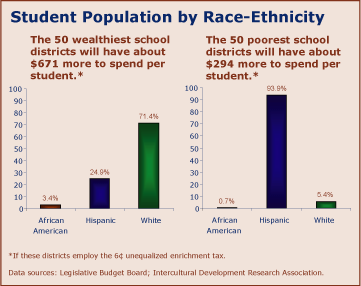• by Albert Cortez, Ph.D. • IDRA Newsletter • August 2006 • 
In May, the Texas Legislature passed its long-awaited school funding plan, HB1. As a result, the gap in funding between wealthy school districts and all the rest will grow by hundreds of dollars per student, school districts will get across-the-board increases in funding without regard to wealth or need, special needs of districts and students will continue to be under-funded, schools will be saddled with an array of new “reforms” with very little promise of improving achievement and little or no new money to implement them, and the state will face a revenue shortfall by the 2007 legislative session.
No matter how much spin is touted by proponents of the latest plan to “improve” education in Texas, the outcome of the special session gets a grade of D. (The only reason it does not get an F is that some very limited increases in funding were provided to all schools.) Efforts by a number of legislative members to improve the outcome notwithstanding, Texas lawmakers once again fell far short of doing much that will improve either quality or equity in Texas public schools.
Compounding their failure was the fact that they spent over $10 billion of new state tax revenue, and close to $3 billion of an unexpected “windfall” (from state funds that had been reserved for public education, but left un-appropriated in the 2005 regular legislative session), to accomplish very little.
With so much hype being generated by the state’s political leaders, it is helpful to take time to separate fact from fiction and then determine what has or has not really been achieved, and where the state needs to go from here.
 Increased Inequity Takes Us Back a Decade
Increased Inequity Takes Us Back a Decade
The legislature adopted a new provision to address the Supreme Court’s requirements related to “meaningful local discretion.” The new plan allows local districts to “enrich” the state’s foundation funding by a total of 6¢ (up to 4¢ in 2006-07; and with local voter approval up to 6¢ in 2007-08).
Wealthy schools will be excused from sharing this enrichment tax revenue via recapture.
Although state leaders had not considered or been concerned with the impact that such totally unequalized enrichment would have on the equity in the overall system, strong efforts by a bi-partisan group of legislators led to the adoption of some equalization features in this new enrichment tier. Those efforts resulted in the incorporation of a guaranteed yield feature similar to that in current law where all districts are assured a certain level of return for every penny of local tax effort.
For instance, if a local school district only generates $10 per penny of tax, but the state guarantees $30, that district gets an additional $20 in state funding. If the local district generates only $20 per penny of tax, it gets an additional $10 in state aid. This “guaranteed yield” portion of the funding system results in equal return for equal tax effort – one of the fundamental requirements the courts had outlined in earlier Texas school funding cases.
Though the guarantee of $41.19 per penny of tax guaranteed to all school districts helped reduce the growth in inequity, the fact is that more than 100 school districts generate more than that amount per penny of tax. In fact, as many as 31 school districts generate more than two times that total.
The failure to require recapture at the enrichment tier, coupled with the state’s arbitrary decision to limit enrichment equalization funding to the level of Austin ISD’s yield, increased the amount of inequity in the Texas funding system.
The House and Senate debates reveal that many legislators were aware that they were increasing inequity but voted for it anyway. Some were being pragmatic, believing that this was the best that could be accomplished. Others were swayed by contentions that providing $41.19 for each penny in the new enrichment tier was the highest level of equalization funded to date. In fairness to some who voted in favor of the plan, the impact projections provided excluded unequalized revenue that would be available under the new plan.
A closer look however, reveals that this claim of never-before-achieved levels of equalization funding was over-stated. The guaranteed yield applies only to 4¢ of a maximum tax effort of 137¢ in 2006-07, and an overall tax effort of 106¢ in 2007 and beyond. For the majority of tax effort, the state guarantee remained at a modest level of $31.90 per penny of tax, not a major improvement over the $27.14 per penny of tax levels of equalization funding provided in the plan that HB1 has replaced.
Most importantly, the bill’s sponsors downplayed the fact that while the 900+ poor and average wealth districts were ensured a return of $41.19 for the new enrichment tax effort allowed, more than 100 school systems would generate much more than that, setting the stage for the greatest increase in the equity gap seen in over 13 years.
After the final debates, the Texas legislature had voted to provide minimal new state funding increases to property poor and average wealth districts to minimally offset the great increase in inequity that resulted from its other actions. It is fair to say that the limited level of funding provided for equalization reflects the low level of concern that many legislators had for equity in educational opportunity in Texas.
The Great Texas Tax Swap
Overall, Texas schools were given the leftovers from the property tax reduction frenzy of 2006. While the legislature stated that a recent court ruling required them to cut local school property taxes, the decision in the West Orange-Cove case did not actually demand property tax reduction in over 60 pages of its narrative judgment. What was ordered, and the only thing required by the court, was that the state change its funding system to provide local school districts some “meaningful discretion” to enrich local programs beyond the levels required by state-mandated programs.
This could have been accomplished without wasting billions of state dollars.
The misdirection in priorities began when the state political leaders appointed a special commission to focus its efforts exclusively on tax reform, rather than the school funding reforms mandated by the courts. Not surprisingly, most of the tax commission’s substantive recommendations dealt with changes in the state tax code. A few changes in education policy came for the most part as after-thoughts from a few policymakers determined to change practices in a small number of specific areas.
The greatest beneficiaries of the property tax cuts were businesses whose major assets include taxable property. While the new-and-improved business tax will create some new costs from such businesses, these will be neutralized by property tax reductions. The increased revenue expected from the expanded business tax will be obtained from many Texas businesses that had previously been excluded from the state’s franchise tax.
Texas property taxpayers will see net reductions in local school taxes, though at least some of those savings will be spent to cover increased business taxes that will be passed on to all consumers.
These property tax savings also will be eroded by increased taxes for used car purchases, where the amount of tax paid will be based not on what one paid for the car – but the Blue Book value.
And of course smokers will be asked to dole out an additional dollar a pack for cigarettes.
After backing out those tax increases, one might have enough money left to pay for a month’ worth of cable or perhaps a month’s cell phone bill for a teenager. Folks who are expecting large property tax reductions that are being touted by a few politicians will be greatly disappointed when their bill arrives.
Wealthy School Systems Get Wealthier
Clear “winners” in the plan are the state’s wealthiest school districts, who received the greatest per pupil benefits from the plan that was adopted. For these property wealthy districts, the benefits took the form of reduced contributions in the amounts of recapture funding collected by the state to help fund the overall system. While such districts were allowed to reduce recapture contributions, the state had to increase state funding to the 900+ school districts who used to receive this funding, just to enable them maintain the same level of overall funding they had in the year before. This decrease in recapture is costing the state of Texas $650 million in 2006-07 alone.
An additional benefit accrued by these privileged systems was the allocation of additional funding in a manner that was not adjusted for local district property wealth, a development that served to increase the level of inequity that is allowed within the Texas funding system.
A hidden benefit to property wealthy schools systems lies in the manner in which property taxes were reduced. Specifically, the reductions in maximum tax rates (from $1.50 to $1.33 in 2006-07 and to $1.00 in 2007-08) mean the state will collect less money from the wealthiest districts. When one divides the reduced recapture amounts by those districts’ weighted student counts, the net savings for those systems totals thousands of dollars per pupil.
Examples include Highland Park in Dallas County, where recapture reductions averaged $2,201 per weighted student, $1,064 in Deer Park in the Houston area, and $1,536 in Alamo Heights in the San Antonio area (based on Legislative Budget Board data on the impact of HB1).
If one thinks of reduced recapture as indirect state support (since the monies previously collected from those systems are now paid from taxes paid by everyone else around the state), the amounts provided by recapture reduction average almost twice the amount of revenue per pupil provided to poor and average wealth districts. Though taxing limits will prevent this wealthiest group from spending all of this former recapture funding for their own programs, at least some of it will be spent using the new enrichment tax level created in the revised system.
Teacher Raise Maintains Salary Gaps
Teachers, librarians and nurses will see an increase of $2,000 in their salaries and the return of the $500 cut in health benefits funding experienced in earlier legislative sessions.
But current inequities were maintained by the use of across-the-board funding, where all districts were given the same amount of funding to pay for those salary increases despite great differences in local property wealth, bypassing the way teachers’ salaries are normally equalized in state funding formulae.
Defenders of the latest plan argue that it is fair because all districts got the same amount of money for those salary increases. But if the payment for those increases had been put through the equalization formula, the salary increases may have been even greater and, more importantly, they could have helped close the un-just gap between teachers who are doing the same jobs (and in some cases under more limited resources) but are being paid less money than others working on the other side of town.
Such salary and benefits disparities create serious problems for school districts trying to retain and recruit teachers, particularly in low wealth systems, rural areas and some major cities.
Non-targeted, Unequalized High School Funding
A similar flaw exists in the new high school allocation that provides $275 per student (ADA) for grades nine through 12 to help schools reduce dropout rates and increase graduation rates. This allocation also lacks any equalization features.
In the great majority of funding that is usually allocated under the state funding formulae, the state and district portions are adjusted based on the ability of school districts to raise money from available tax property located in the district. When funding is distributed strictly on pupil counts, there is no opportunity for increasing equalization, and thus millions of dollars are spent maintaining the unequal status quo.
In the area of dropout prevention, the across-the-board funds mean that suburban schools with very few dropouts will get as much money as schools where dropout rates are much higher, producing windfalls for some at the expense of inadequate support for others.
Proponents for across-the-board unequalized funding have argued that even affluent communities need money. For example, even if they do not have high dropout rates, they might increase the numbers of students enrolling in and succeeding in college. In an ideal world, one would not require school districts to choose between increasing graduation rates and increasing college attendance and success rates. But if one had to choose, it seems critical to ensure that students get through the first hurdle.
The Bottom Line – Billions Spent and Equity Reduced
In the many years in which IDRA has tracked school finance equalization, seldom has the state taken such a drastic step backward in equity. How additional monies for less than 5 percent of schools, who enroll less than 6 percent of all students, was considered more important than the quality of education provided to the other 95 percent is a question that should be asked by all Texas citizens.
As a result of the latest actions, 4.1 million children will be in schools with severely limited resources for qualified teachers, up-to-date curriculum and basic supplies.
The boxes below are based on data provided by the state and additional data derived from IDRA estimates of the impact of new enrichment. They reflect the estimated impact of the new funding system on a sub-group of property wealthy and property poor Texas school districts. IDRA’s analysis found that, in looking at the 50 wealthiest school districts and the 50 poorest districts, there is a great disparity in enrollment demographics. In the 50 wealthiest districts, almost three-quarters of the student population is White, one quarter is Hispanic and 3 percent is African American. Compare this with the 50 poorest districts where only 5 percent of the student population is White, 94 percent is Hispanic and 1 percent is African American.
If they employ the 6¢ unequalized enrichment tax, the 50 wealthiest districts will have about $671 more to spend per student, while the 50 poorest districts will only have $294 more. It is clear from the data that the gap in spending between wealthy and poor districts has been increased.

Some education advocates have attempted to put a positive spin on the end results by declaring how greatly the Texas funding system was improved. It is understandable that some might want to put the best face on what they realize is a bad outcome. Others have been a bit more straightforward and noted that while ground was lost, they felt they had done as much as they thought possible in a hostile political climate. For those who want to deceive, perhaps they believe that if one repeats the lie long enough to enough people it will somehow become true.
So the public will continue to hear that revenue will be made more equitable up to the 88th percentile, while ignoring the fact that the gap in spending is actually larger than it was before the so called “reform.”
We will also hear a reference to the notion that districts will be given as much enrichment tax money per penny as that which is produced by a district at the 95th percentile of wealth, and conveniently ignore the fact that a handful of districts will get to spend dramatically more than anyone else.
They will also forget to mention that for the other $1.33 of taxation in 2007 (or $1.00 in 2008 and 2009), school districts will be assured only an estimated $31.95 per penny. (If you thought Texas school finance was complicated before, the new plan requires accountants to just figure out who is on first base.) Unfortunately, the added complexity in the system also will make it easier to mis-represent the facts and make things seem better than they are.
While one might couch the just-ended battle for state funding as a scene where wealthy districts won and property poor districts lost (which is true) and that a few taxpayers won and most others may have at best broken even, the greater truth is that the state of Texas as a whole lost, and lost in a way that may take a long time to unravel.
Taxpayers in fact will lose. Short-term property tax reductions will be followed by creeping increases in property taxes or other state tax increases will be required to improve the quality of Texas public schools and to at least maintain other state services.
The citizens of Texas also will suffer from continuing legal costs to defend an under-funded and more inequitable system. There is little doubt that a challenge to the new funding plan will be initiated perhaps no later than the fall of next year as school districts recognize that the meager increases in funding do not give enough support to provide an adequate, let alone a quality, education for all students.
The state of Texas will continue to suffer as it fails to produce high quality graduates from all schools. And even the new money targeted to reduce dropouts, because it is not targeted to those students and schools with the greatest needs, does little to change an unacceptable status quo.
Ultimately the students in the great majority of Texas schools will suffer as a result of a system that is grossly under-funded and produces schools where the quality of education that a child receives – even more than it has been over the last few years – is based on the wealth of the neighborhood in which he or she happens to live.
To allow such a unique opportunity where the chance for substantive tax reform was wasted to return the state to a level of inequity not seen since the early 1990s is nothing less than shameful. No matter how much rhetoric one hears about the great strides that were made, the real truth is that we are all going to be the poorer for it over the long run.
Leadership was again needed, and the state’s leadership once again failed. Our children, all Texas children, deserved better.
Other Measures Passed in the 2006 Texas Special Session
|
In addition to the measures discussed in detail in this newsletter, the Texas Legislature included a number of other items in its school funding plan.
Source: House Bill 1, 79th Third Called Session of the Texas Legislature (2006). |
Albert Cortez, Ph.D., is the director of the IDRA Institute for Policy and Leadership. Comments and questions may be directed to him via e-mail at: feedback@idra.org
[©2006, IDRA. This article originally appeared in the August 2006 IDRA Newsletter by the Intercultural Development Research Association. Permission to reproduce this article is granted provided the article is reprinted in its entirety and proper credit is given to IDRA and the author.]



